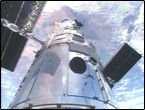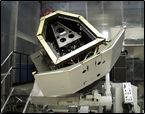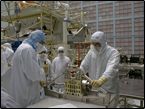Early History
 In June 1997, NASA made the decision to extend the HST mission from 2005 until 2010. As a result, the age and condition of the instruments on board the HST became a consideration that had to be revisited.
In June 1997, NASA made the decision to extend the HST mission from 2005 until 2010. As a result, the age and condition of the instruments on board the HST became a consideration that had to be revisited.
After careful study, NASA decided also to ensure the imaging capabilities of the HST by replacing the Wide Field Planetary Camera 2 (WFPC2), with a low-cost, "facility" instrument, the Wide Field Camera 3 (WFC3).
As a facility instrument, WFC3 is produced as service to the astronomical community. The WFC3 developers do not get guaranteed observation time on HST. While this concept is new to HST and the Space Sciences community, it has been successfully used by both the Planetary and Earth Sciences communities in their instrument development projects.
 In addition Wide Field Camera 3 represents a new approach to the development of HST scientific instruments. The teams of Government, Academia, and Industry who worked to build the Wide Field Planetary Camera 1, WF/PC (1), WFPC2, and several other HST instruments are working together on WFC3, leveraging their experience to provide a superior instrument at modest cost.
In addition Wide Field Camera 3 represents a new approach to the development of HST scientific instruments. The teams of Government, Academia, and Industry who worked to build the Wide Field Planetary Camera 1, WF/PC (1), WFPC2, and several other HST instruments are working together on WFC3, leveraging their experience to provide a superior instrument at modest cost.
The WFC3 project is also designed to take advantage of much of the hardware and software of the previous instruments. WFPC1 was returned following the First Servicing Mission (FSM), and many of its assemblies are available for reuse. Flight designs, and in some cases, spare flight hardware, are available and can be used in WFC3 for minimal cost.
1997 - Extending Hubble's Mission
 The 2002 Instrument Selection Review Panel met in June 1997 and selected the Cosmic Origins Spectrograph (COS) as the instrument to develop for Servicing Mission 4 in 2003. Servicing Mission 5 (2005) would be the final, "deorbit" mission. Shortly after this meeting, NASA made the programmatic decision to continue operation of HST at least until 2010. The last Servicing Mission for upgrading HST was then changed from late 2002 to early 2003, with the deorbit mission deferred until after 2010. The current plan is to cancel the 2005 Servicing Mission.
The 2002 Instrument Selection Review Panel met in June 1997 and selected the Cosmic Origins Spectrograph (COS) as the instrument to develop for Servicing Mission 4 in 2003. Servicing Mission 5 (2005) would be the final, "deorbit" mission. Shortly after this meeting, NASA made the programmatic decision to continue operation of HST at least until 2010. The last Servicing Mission for upgrading HST was then changed from late 2002 to early 2003, with the deorbit mission deferred until after 2010. The current plan is to cancel the 2005 Servicing Mission.
As a result of the decision to extend the HST mission, the Project initiated a number of studies to address the issues of resource availability. Specifically, to understand how to maximize HST's scientific productivity and competitiveness until 2010, using available resources. These issues range from the optimal approach to building state-of the art spacecraft hardware, to the scientific strategy for HST in its second decade of operation. The WFC3 project is the result of one such study, chartered by NASA Headquarters, which addresses the imaging capability of the HST through 2010.
The study charter recognized that in the period 2002 to 2010, an adequate imaging capability on HST may not be assured. In 2010, HST's primary imager, the Advanced Camera for Surveys (ACS), will be 11 years old. The current imager, the Wide Field and Planetary Camera 2 (WFPC2) will be 17 years old. The Space Telescope Imaging Spectrograph (STIS), which has some limited imaging capability, will be 13 years old. The study addressed the feasibility and cost of a backup wide-field camera.
1998 - Proposing a Second Channel
 In January 1998, the results of the study were presented to the same 2002 Instrument Selection Review Panel that selected the COS instrument.
In January 1998, the results of the study were presented to the same 2002 Instrument Selection Review Panel that selected the COS instrument.
The detailed results of the study were presented as two options. Option I provided for a backup of the wide-field imaging capability only. Option II encompassed Option I and added an optimized coronagraph capability. The panel recommended proceeding with Option I.
After a favorable review by the Origins Subcommittee in March 1998, the HST Project was directed to begin WFC3 development with Option I. However, in October of 1998, the Space Telescope Institute Committee (STIC) formally resolved that "the STIC is convinced that significant advantages would accrue from the inclusion of a near-IR channel in WFC3" and encouraged "STScI and NASA ...To identify funding sources, perhaps even within the Hubble Project and the HST User community.
In November, 1998 the Cycle 8 Telescope Allocation Committee (TAC) asked to be briefed on the WFC3/NIR concept. The TAC made the following formal recommendation:
"The TAC believes that the potential scientific return from adding this channel is enormous," and "...Is unanimous in its view that addition of this capability will greatly enhance the scientific output of HST during the period 2003-2010."
"We strongly encourage NASA to (1) proceed with design and costing of the IR channel over the next 6-8 months; and (2) to select a design that achieves an appropriate balance between UV performance and IR capability,"
"...urges STScI and NASA to explore a wide range of additional creative approaches to funding WFC3/IR, including the possibility of reducing the funds available to GO's by 5% over the next 3 years, if no other options are viable."
1999 - Approving the Second Channel
 In March 1999, the NASA Origins Subcommittee Report strongly endorsed the scientific case for a near-IR channel for WFC3, based on a preliminary concept from the project.
In March 1999, the NASA Origins Subcommittee Report strongly endorsed the scientific case for a near-IR channel for WFC3, based on a preliminary concept from the project.
The Subcommittee Report stated that the "...inclusion of an IR channel... would allow HST to address a significantly expanded range of important problems, including the history of star formation both within the Galaxy and extending to galaxies at high redshift." (The image shows an infrared study done by Hubble's NICMOS instrument).
WFC3 would use a more advanced version of the detectors used on the HST Near-Infrared Camera and Multi-Object Spectrometer (NICMOS) instrument. These WFC3 detectors would provide a factor of 16 increase in the number of pixels, and over a factor of two increase in quantum efficiency. An innovative design would allow the instrument to use simple, low-cost thermoelectric cooling systems instead of the cryogens or mechanical cryocoolers that are typical in other IR instruments.


